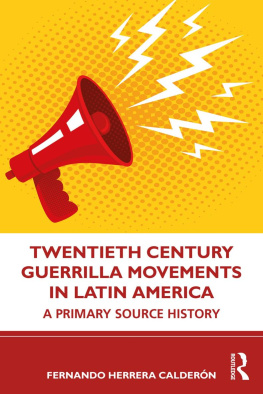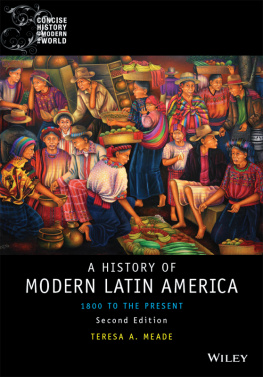Thank you for buying this ebook, published by NYU Press.
Sign up for our e-newsletters to receive information about forthcoming books, special discounts, and more!
Sign Up!
About NYU Press
A publisher of original scholarship since its founding in 1916, New York University Press Produces more than 100 new books each year, with a backlist of 3,000 titles in print. Working across the humanities and social sciences, NYU Press has award-winning lists in sociology, law, cultural and American studies, religion, American history, anthropology, politics, criminology, media and communication, literary studies, and psychology.
Faces of Latin America
Copyright 2013 by Duncan Green
All Rights Reserved
Library of Congress Cataloging-in-Publication Data
available from the publisher.
The right of Duncan Green to be identified as the author of this book has been asserted
by him in accordance with the Copyright Designs and Patents Act, 1988.
U.S. ISBN: 978-1-58367-324-9 (paper)
U.S. ISBN: 978-1-58367-325-6 (cloth)
Published in North America by:
Monthly Review Press
146 West 29th Street, Suite 6W
New York, New York 10001
www.monthlyreview.org
Distributed in the UK by:
Latin America Bureau
Enfield House, Castle Street
Clun, Shropshire SY7 8JU, UK
http://www.lab.org.uk/
UK ISBN: 978-1-899365-76-0 (paper)
5 4 3 2 1
Introduction
Latin America has long been portrayed to the outside world through stereotype and myth. It started back in the sixteenth century when El Dorado, the mirage of a golden king in a golden city, first excited the Spanish conquistadores greed. Back in Europe, idealized accounts of the Inca and Mayan civilizations inspired Thomas Mores Utopia. The West has both plundered and been dazzled by Latin America ever since. Some of the greatest Latin American writers, such as Mario Vargas Llosa, Isabel Allende, and Gabriel Garca Mrquez, were, in the words of one critic, the equivalent of the Amazon rainforest, providing oxygen for the stale literary lungs of the developed world.
But recently Latin American writers, weary of magic realism, have turned their attention away from the sleepy rural world of Garca Mrquezs Macondo to the drugs and violence that face so many Latin Americans in their daily lives. Chilean author Alberto Fuguet ironically brands the new genre McOndo, yet another Latin syncretic combination of old and new, external and internal influences.
This book tries to paint a picture of this complex and often contradictory society. It is about Latin Americans: not just presidents and businessmen, some of them among the richest in the world, but the millions of faces of the shantytowns, small farms, mountains, rain forests, factories, and plantations. It explores the processes that have shaped peoples lives, the jobs they do, where they live, and how they see and want to change their world. Through the lives of its inhabitants, the book attempts to capture the everyday ebullience and dynamism of Latin America, a world away from the cynicism and corruption of much of its formal political life.
Far from being the passive victims of circumstance, ordinary Latin Americans possess depths of courage and creativity, enabling them to confront with humor and grace a seemingly endless array of problems: how to feed and educate their families, find a home, improve their neighborhood. Many such attempts at self-help have in recent years been led by women, struggling to free themselves from the stifling values of machismo. The indigenous peoples of Latin America have also belied their reputation for passivity by fighting vigorously to defend their ways of life.
Today the region is imbued with a new feeling of optimism, despite the dispiriting number of obstacles it still faces. The last two decades of the twentieth century saw a debt crisis usher in a devastating sequence of market reforms, bequeathing a harsh world where economic growth did not create jobs, and the gulf between rich and poor grew ever wider. Since then, however, a series of left-of-center governments have gained power in much of the region and the economy has rebounded. In some countries modest progress has been made in combating the regions age-old scourge of income inequality, the worst in the world.
Yet many are asking whether the region has found a sustainable way forward. It remains heavily dependent on the export of primary products, in some countries even more than in the past. The rural poor are still struggling for a plot of land on which to feed their families in an environment devastated by deforestation, soil erosion, and unregulated mining and industrial development. Unemployment and violence, much of it related to drug-trafficking, remain high in the shantytowns that encircle the regions cities.
Old problems perhaps, but also a new vitality. The return of civilian rule to almost all the region has imbued many Latin Americans with the belief that they can and should have a say in determining their countrys future. Through social media they are creating new forms of protest, new ways of organizing. This book aims to help you understand the roots of this new Latin American effervescence.
Faces of Latin America was first published in 1991, in the run-up to the 500th anniversary of Christopher Columbuss first voyage to the Americas. Much has happened since then and this fourth edition, covering developments up to 2012, has been extensively rewritten as a result. With this new edition, the mood of the book has also evolved. As the traumas of dictatorship, civil war, and economic collapse recede, a more positive story emerges: the rest of the world has much to learn from the vigor, imagination, and courage of millions of Latin Americans as they struggle for a better future.
DUNCAN GREEN
and SUE BRANFORD, 2012
1.
The Curse of Wealth: Economics












